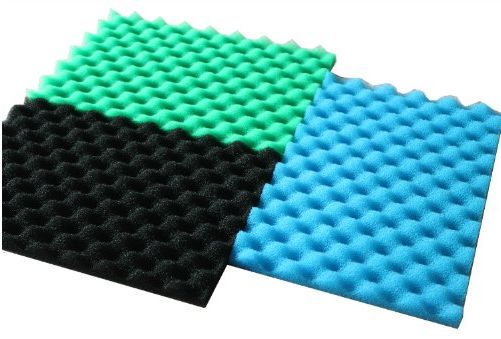
Foam is simply the best biomedia to put in any static aquarium filter. The ability of foam to biofilter the water and give crystal clear, very healthy water is simply the best of any static media.
The only “more effective” media than 30 ppi foam is fluidized bed K1 media. On a cubic inch of filter basis fluidized K1 media is close to 60% more efficient than 30 ppi foam.
The static 30 ppi foam compares to the fluidized K1 as follows:
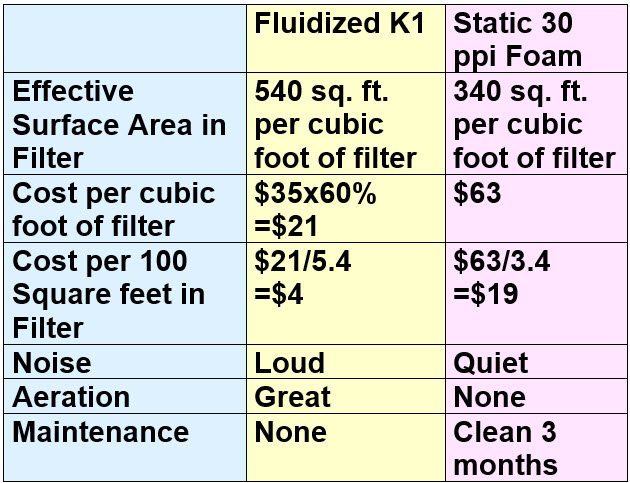
If one is a nerd like the author one might be interested in this long boring article on why foam is such a good static filter media for aquarium filters. It includes testing which proves this is true.
This is the surface area from published data from Swiss Tropicals , the supplier of Poret Foam. Our testing data and math calculations say this is very accurate.

Swiss Tropicals is the ONLY manufacturer which tells the truth. This is really kind of amazing when one thinks about it.
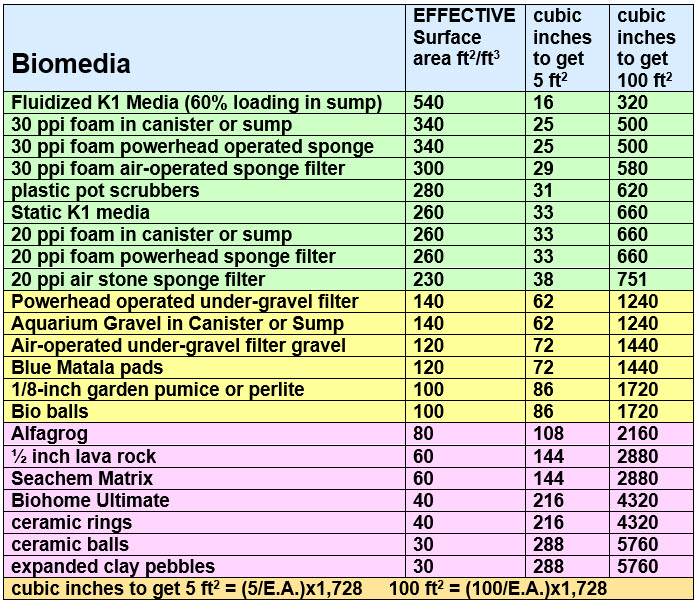
Many well meaning but ill-informed commentators on social media dismiss the urethane foam layers in a canister filter as just mechanical filters which need to be frequently cleaned. Nothing could be further from the truth. Urethane foam of 30 pores per inch or less (ppi) is a superb media for biofiltration if it is never thoroughly cleaned and decent water flow is maintained. It has the highest usable surface area of any biomedia and has a microstructure very amenable to biofiltration.
But a word of caution is warranted. 30 ppi foam will function great and not plug with light stocking and a large volume of foam. If one goes to heavy stocking with a small volume of 30 ppi foam one CAN POSSIBLY clog rapidly. It also depends on other parameters such as inoculate and protein content of the food. Inoculate from a pond has worms in it which literally “eat” the brown gunk. And a low protein (less than 40%) food will create much more brown gunk than a high protein food. From personal experience it seems to be somewhat bimodal. The 30 ppi foam will either plug in weeks or never plug at all.
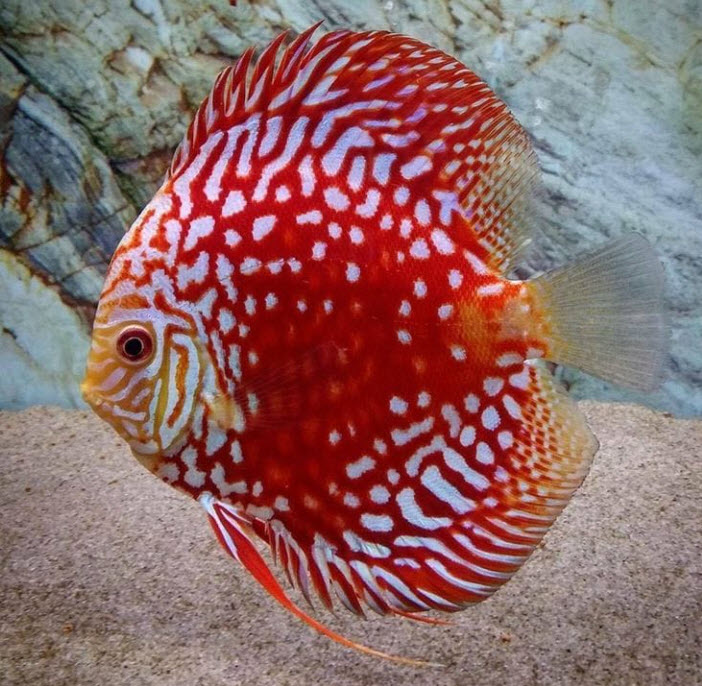
I normally avoid anecdotal evidence but sometimes it is very revealing. A comment on this website from “Jim” is warranted here:
“An Amazon seller sells a set of nine “Aquaneat” filter pads for the Sunsun x04 filters, three each of 20 PPI (blue), 30 PPI (green), and 40 PPI (black). They are cut very precisely and fit perfectly—three pads fill one tray completely.
Well over a year ago, I bought two sets and put all six 20 PPI pads in the lower two trays of a 304 and then all six 30 PPI pads in the upper two trays (and threw the 40 PPI pads in a junk box in the basement). This is on a 55-gallon tank stocked with (please don’t call the goldfish police!) 14 comet sarasas–long story but I had to salvage them from a pond with a failed filter and liked them inside so never put them back.
I initially seeded it by putting media from the failed pond filter in the tank, along with some soil from my wife’s vegetable garden—it was cycled within two or three days.
I do weekly 50% water changes to keep nitrate below 40 ppm, the water is crystal clear, and the fish are active and beautiful. As far as I can tell the filter flow has still not slowed at all, so I have not opened the filter again, although I’m really tempted to.
I recommend this setup most highly to the followers of your site who are willing to believe you that foam is the best filter media.“
And here is a follow-up comment
“Hi Jim,
I have a 20 gallon tank that has a polar aurora filter, which is similar to a smaller SunSun. I used those aqua neat sponges in all 3 trays. I also have a small pre-filter sponge on the intake of the canister. I opened the filter after 6 months of use. I didn’t really notice a decrease in flow, but I wanted to check to make sure it wasn’t clogging up.
When I opened the filter, it had next to nothing in it. I was very surprised. I just put the trays back, closed it, and will let it go another 6 months. Unless I notice a decrease in flow. But yea, I was very surprised how clean it was inside.”
These results are 100% in line with what my testing showed. It is anecdotal but interesting.
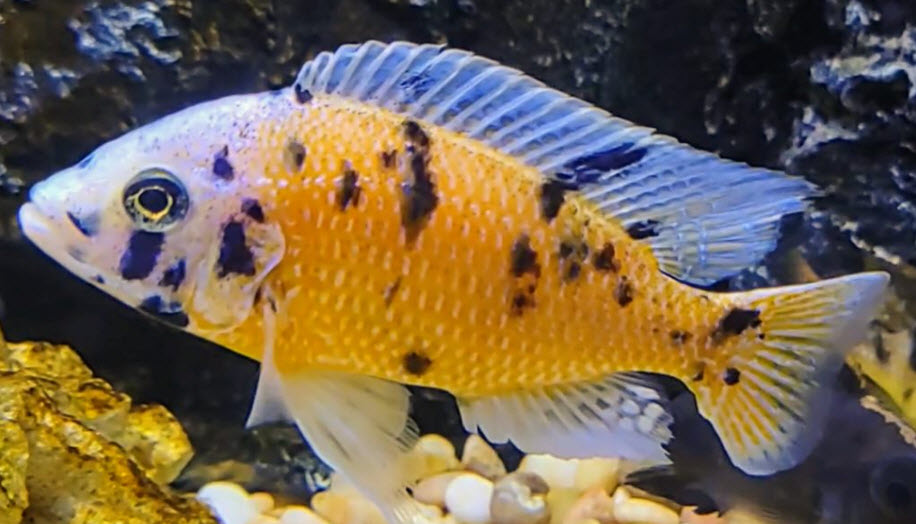
The Structure of Foam
Urethane foam has a “free void” property of around 90% with a huge usable surface area. This is an unbeatable combination for biofiltration. The structure of the foam (the “morphology”) is the reason the foam works so well for biofiltration. This foam is a reticulated open celled urethane foam.
This structure has a huge surface area and a very good structure for colonies of beneficial bacteria. Foam with 10 to 30 ppi (pores per inch) has openings large enough that they aren’t easily clogged yet has a very large surface area. This is a combination difficult to come by in biomedia.
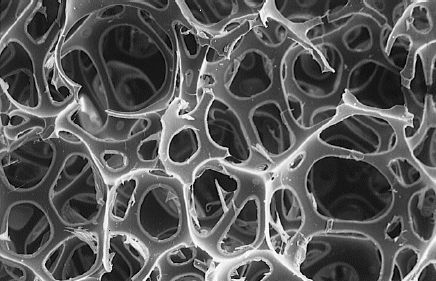
Open celled reticulated urethane foam comes in different pore sizes. The size of pores is measure in pores per inch (ppi). The foam with higher ppi has more pores in it. More pores mean larger biological filtration capacity but faster clogging. A coarse foam will be 20 ppi, a fine foam will be 40 ppi.
The best arrangement by far for foam media is to put the flow of the aquarium water through a series of foam pads in an exterior filter (typically a pressurized canister but sometimes a sump filter). Flow the water through as many 20 or 30 ppi foam layers as can be put in the filter. This is the biofilter and should be cleaned only when the flow through the canister diminishes. This is a great way to filter aquarium water.
Avoid 40 ppi foam as it requires frequent cleaning. 40 ppi foam IS a mechanical filter material. Only use 40 ppi foam in EXTREMELY over filtered aquariums. If one has more than 100 square feet of surface area per pound of fish, good aeration, and a high protein food, 40 ppi can be use as a biofilter.
20 or 30 ppi foam can support two to ten times more beneficial bacteria per cubic inch than most other media. This is the reason it is so popular. If it isn’t thoroughly cleaned it is simply the best biofiltration media available.
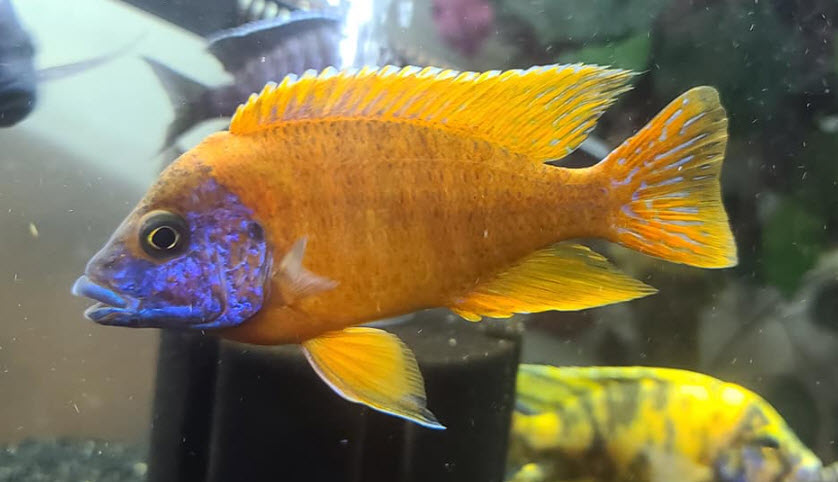
The Biology of Foam
From the Poret Foam Supplier (Swiss Tropicals):
“The purpose of the foam is not to filter the water as is often assumed. The foam serves as the habitat for a vast array of microorganisms that include bacteria, archaea, worms, ciliates, flagellates, and many others. These microorganisms live in a community that is based on biofilms. The biofilms are created by bacteria that secret extracellular polymeric substance (EPS), which is often called “slime”. The community forms a bioreactor that processes the waste and turns it into food and energy for its members, and ultimately into organic or inorganic products that are then used by plants, evaporate, or removed by water changes. It takes a considerable amount of time to establish this “filter community”; consequently, it is very important not to disturb it unless absolutely necessary. The brown filter sludge in a filter is for the most part alive and not simply waste. Removing this mud does more harm than good.”
This is one of the most intelligent things any aquarium equipment supplier has ever written.
This biological filtration capability of foam is best illustrated by a series of diagrams:
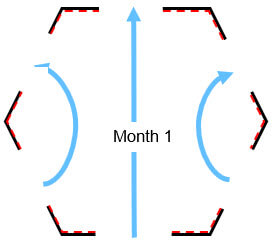
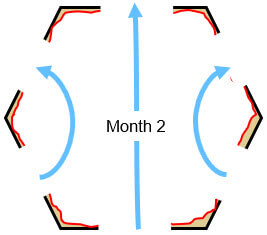
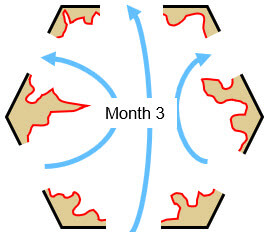
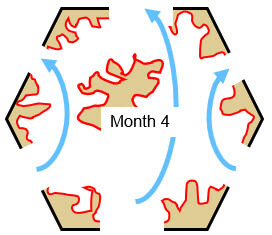
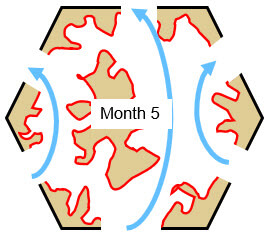
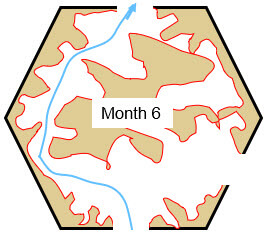

The red lines are the important lines. These represent where the beneficial bacteria can do what they do. The surface area of the beneficial bacteria exposed to the flow increases with time until such time as the flow becomes restricted by the brown gunk. This means it is important not to clean this material until the flow slows.
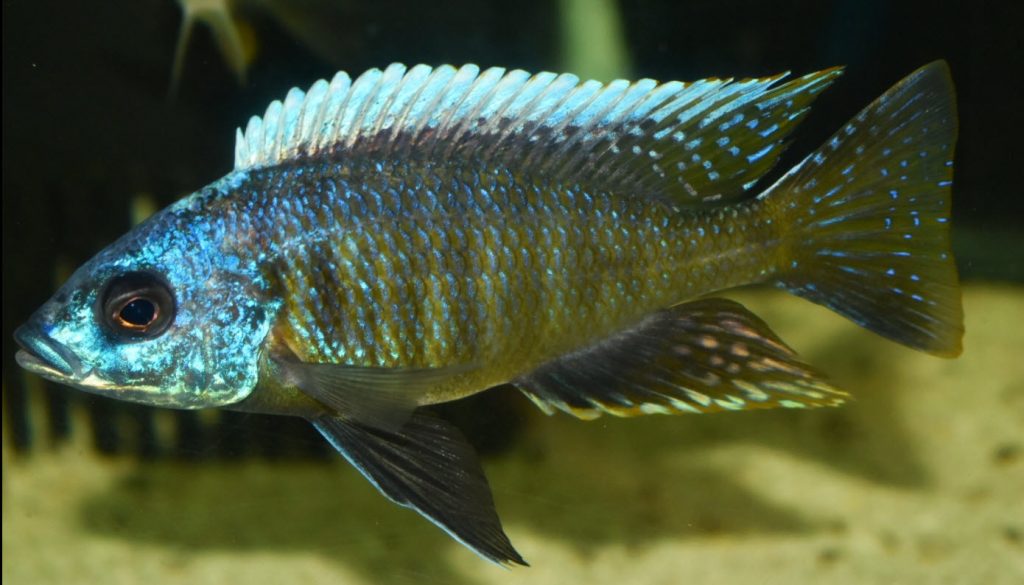
The Mistake of Over-cleaning
Probably the most common mistake in the hobby is to clean biomedia like foam frequently because “obviously they are filled with fish poop”. If foam is squeezed more than four times testing shows the filter needs to be completely recycled. The beneficial bacteria can be removed that easily. To see this test click on this link:
6.8. Thorough Cleaning
.
Testing Foam as a Biomedia
The various biomedia used in the hobby were tested. They were tested in actual conditions that would prevail in the aquarium. Foam came out as being roughly 10 times better at oxidizing ammonia than ceramic rings, lava rocks or Matrix media.
A test of ammonia oxidizing capability of various filter media was run. The first number, the “efficiency” is the average ammonia oxidizing that 15 cubic inches of media accomplished over a 90-day period. The second number is the “effective” surface area in square feet per cubic feet calculated from that test. The third number is the effective surface area in square feet per cubic feet calculated by simple mathematics. The correlation between the test results and the calculated surface area is very significant and means the testing was accurate.
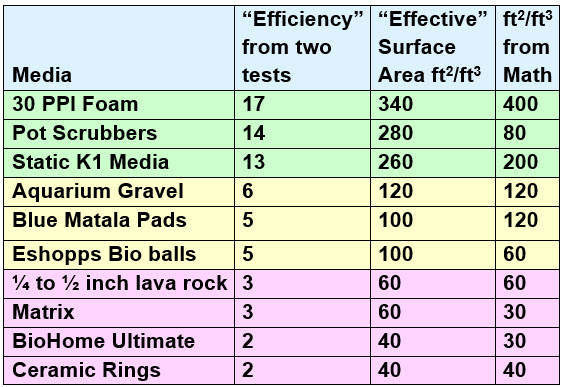
The higher the numbers here the better the media. This makes 30 ppi foam the best media and ceramic rings the worst media.
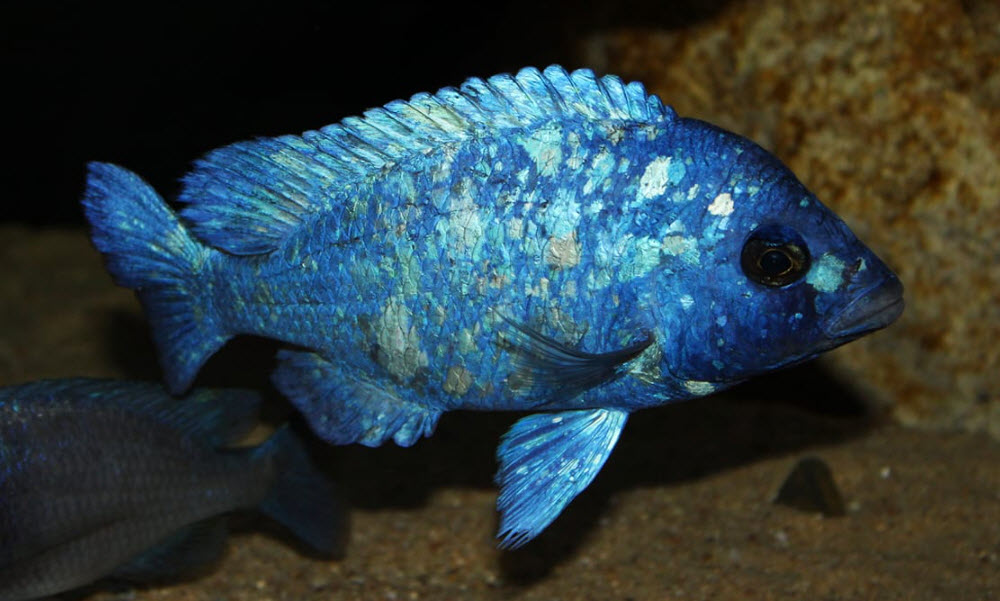
“Sponge” (Foam) Filters
Simple air stone operated “sponge” (more properly called urethane foam) filters are very good filters sold in all aquarium stores for less than $10. They are deservedly the most popular aquarium filter for breeders. They are ugly, and it is unusual to see them in a decorative aquarium.
But because they are urethane foam they are decent biofilters which rarely have ammonia problems. And the air stones they are typically used with, aerate modestly stocked aquariums surprisingly well unaided.
They are used in the thousands by breeders of aquarium fish. They make superb filters in an aquarium with fry. It is important with these sponge filters to clean them by only swishing them in a pan of water and squeezing once or twice to remove roughly three fourths of the brown gunk in the filter. Never remove all the “gunk” from a sponge filter.
Never put sponge filters under running water. This washes out too much of the beneficial bacteria. Only swish the sponge back and forth and squeeze once or twice in a bucket, pan or tub.
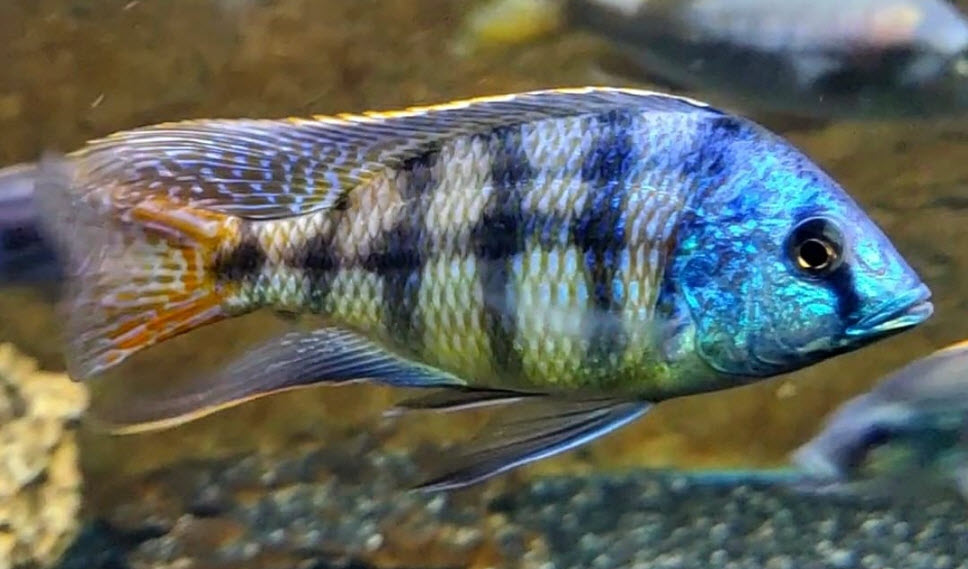
And the idea that a small amount of chlorine in the tap water will do much to the large amount of organic matter in a cycled sponge is simply incorrect. Simple math says the chlorine in ten gallons or so of rinse water is tiny compared to the amount of organic material in a typical used sponge filter.
From Swiss Tropicals, the supplier of Poret Foam:
“It does not matter if you use cold or chlorine-treated water! The often repeated notion that this process would kill all the filter organisms is nonsense, because the residual chlorine concentration in drinking water is too low to kill them all. The microorganisms are quite well-protected in the slime of the biofilm.”
Testing confirmed this lack of sensitivity to chlorine. To see this test click on this link:
6.8. Thorough Cleaning
.
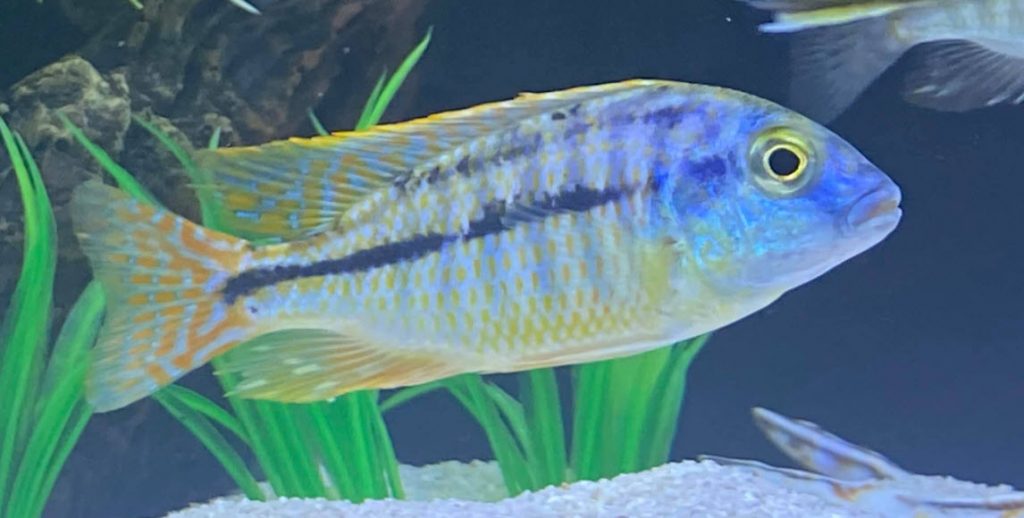
Foam in a Canister
The same material used in a “sponge” filter is used in a canister filter where it is called “foam”.
Many use a graduated series of foam layers, 20 ppi first, then 30 ppi, then 40 ppi. This uses the logic that foam is a mechanical filter material and needs to remove larger particles first then smaller particles. This is just wrong. Sorry, can’t sugar coat it. ONLY the 40 ppi foam acts as a mechanical filter. With this “graduated” progression the 40 ppi will rapidly plug and need to be cleaned once a week. The problem comes here when the hobbyist cleans ALL the foam once a week. Every time they do that they restart the cycle.
.
20 and 30 ppi Foam is NOT a mechanical filter material and should not be used that way
.
Foam is a very good biofilter. It should be used that way. Use either 100% 20 ppi or 100% 30 ppi foam in a canister. Combinations are pointless.
Filter pads of foam have some glaring problems. If they don’t fit well in the filter water will move around them rather than through them. So, they need to be carefully cut to fit for many filters. They can’t just be poured or stuffed into a filter.
If you want to cut your own foam I do not recommend a cheap foam. You can’t tell how many pore per inch (ppi) this foam has nor whether or not it is suited for the aquarium. Rather go direct to Swiss Tropicals and get 20 ppi Poret foam. Note Poret foam is only available from Swiss Tropicals, the agent for Poret, it isn’t sold on Amazon or eBay.
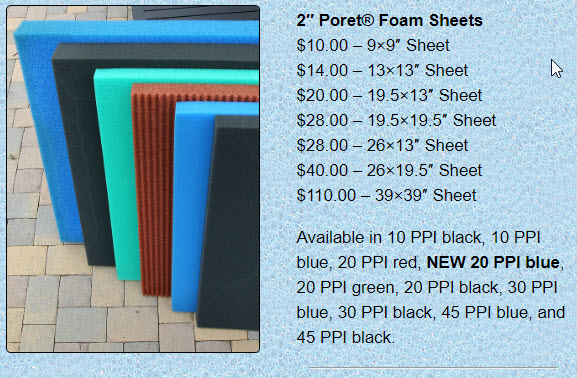
Mattress Foam
Some folks have used the cheap foam pads used for mattresses to filter ponds in large sumps. The cost if this material is about $0.50 per 100 square feet of biofiltration so it is not a material to be lightly dismissed.
The ppi on these mattress foams is quite high (60?) and they will require frequent cleaning unless they are used in a system in the range of over 500 square feet of biomedia (i.e. large volumes of foam) per pound of fish. In such a system the loading is such that the foam will never plug up. If this foam is used in a situation where there are small volumes of foam per pound of fish the foam will plug in days.
If looking at mattress foam buy one foam piece and test it by blowing though it with your lips on the foam. If your breath passes easily through the foam it will be a decent biofilter. If your breath meets resistance the foam is a “memory foam” and cannot be used for filtration. Using mattress foam is a tricky proposition best left to DIY pond enthusiasts.
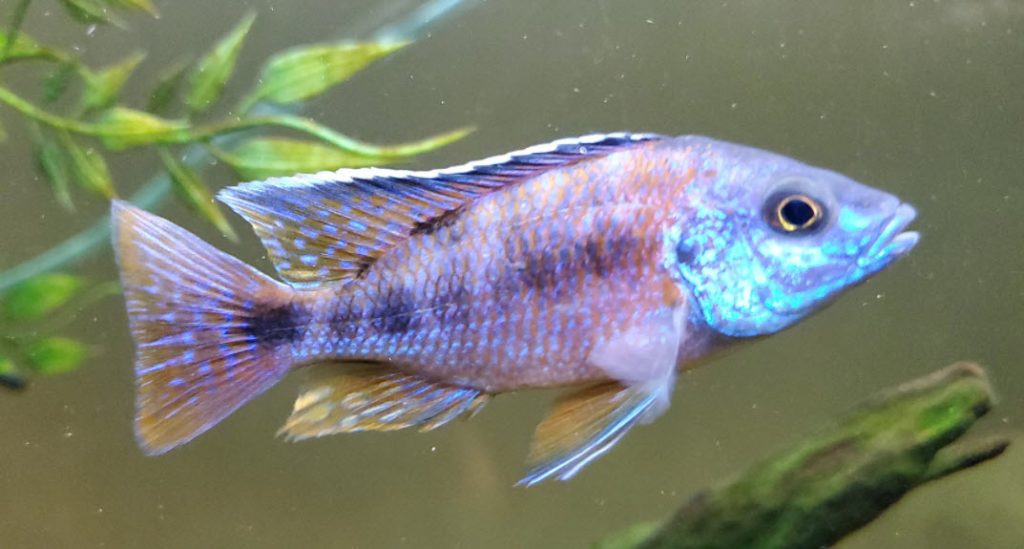
Fluval FX filter Foam
There is one very commonly quoted You-tuber, the Pondguru, who says to replace the foam inserts in the FX series filters with two layers of foam, one 20 ppi and one 30 ppi. This is just the dumbest video ever made. Sorry, can’t sugar coat it. The only thing doing this accomplishes is to put money into the pocket of the Pondguru, who coincidently sells very high priced foam.
The foam arrangement in the FX series of filter is a very good arrangement. The filers should be left in place till the flow slows, which is typically six months. Do not follow the directions that comes with the filter and replace the pads every month. This is simply Fluval blatantly trying to increase their profits.
The FX foam will be fine for four to ten years. It will discolor but that is not a bad thing. The discoloration is beneficial bacteria. The foam will last a lot longer if it isn’t squeezed. Just rinse it lightly by swishing it twice in a bucket or tub of water. Do not rinse it under flowing water.
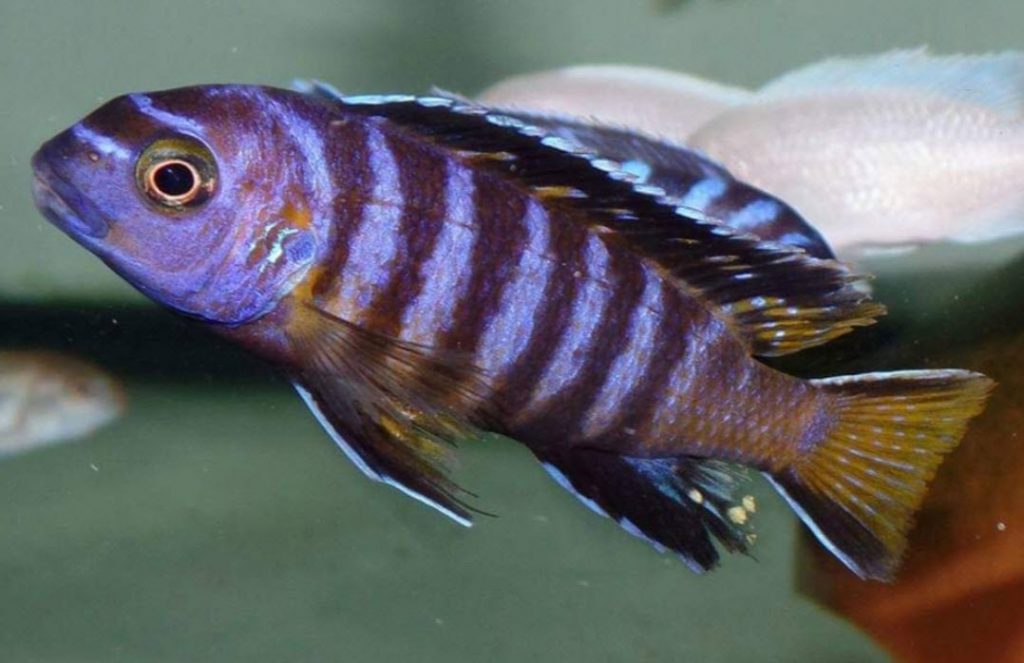
Types of Sponges
There are several types of “sponge”.
- Some enterprising folks use things like car wash sponges. These sponges do not have a structure which is good for aquarium filtration. Air and water do not pass freely through them and they simply won’t work in an aquarium.
- Some car wash sponges are natural sponges which decompose very rapidly in an aquarium and need to be avoided at all costs.
- One type of “sponge” is rectangular squares used to clean dishes. These “sponges” are made of cellulose with very irregular small to large sized holes. They look the same structurally as the natural sponges that are harvested from the ocean. They decompose in weeks in freshwater. They are decidedly not good biomedia.
- Another type of sponge is white or blue and made with melamine. This is a relatively closed cell foam which doesn’t pass water through it freely and shouldn’t be used for biofiltration.
- Then there is urethane foam. This is what most “sponge” aquarium filter media is made out of.
I avoid cheap Chinese foams. Some of this material is formulated with plasticizers and doesn’t hold up to well. Some of it is a type of chemistry called a “polyester” urethane which decomposes much faster in water than a “polyether” chemistry. The pore size of cheap foam from China is also rarely specified. It is “micro”, which might be anywhere from 30 to 50 ppi (pores-per-inch) foam and “macro”, which is I guess might be anywhere from 15 to 30 ppi foam.
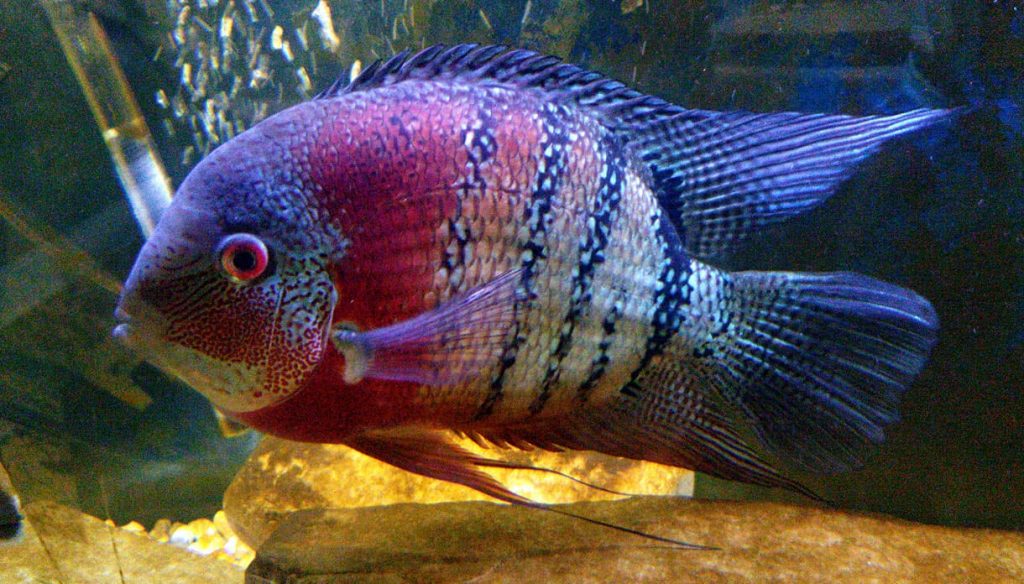
The best foam by far is a product called “Poret Foam”. This Poret Foam is supplied in the USA by Swiss Tropicals. This is a polyether foam with a known pore size, no plasticizers and made specifically for the aquarium trade. It has a high compressive modulus and compressive strength and has given me very consistent long service. And, while Poret foam is expensive, I have found Swiss Tropicals to be the ONLY manufacturer of aquarium products which tells the truth. So I try to support them whenever I can.
For a reasonably priced very good powered DIY sponge filter take the holed Poret foam filter cartridges (Black 20 PPI – 6x6x19.5″ – 1″ hole – $30.00) and cut them up into three ~six inch lengths. Then add a capped and drilled 1 inch PVC seven inch tube and fill the tube with large stones to weight it down. The affix the powerhead. Easy! If you have a breeding tank, just use a twelve inch tube and an airstone to move the water (much safer for fry). Put some gravel or stones in the lower portion of the tube to weight it down.
.
Return to Filter Media Menu
Return to Filter Media Menu
.
Aquarium Science Website
The chapters shown below or on the right side in maroon lead to close to 400 articles on all aspects of keeping a freshwater aquarium. These articles have NO links to profit making sites and are thus unbiased in their recommendations, unlike all the for-profit sites you will find with Google. Bookmark and browse!
.

Dave says
The snails are just fie in there. Just leave them be unless they are significantly slowing down the flow.
Nathaniel Hailey says
I filled 2 FX6 filters with Poret foam as you recommend. Almost a year later I took one filter apart and was shocked how clean it was but there were 1,000’s of tiny snails. Will these snails prevent the foam from filling with brown biofilm and growing the beneficial bacteria l need? Do I need to clear out these snails or are they fine in there? Thanks so much for your site!!
Nathaniel says
I filled 2 FX6 filters with Poret foam. Almost a year later I took one filter apart and was shocked how clean it was but there were 1,000’s of tiny snails. Will these snails prevent the foam from filling with brown biofilm and growing the beneficial bacteria l need? Do I need to clear out these snails or are they fine in there? Thanks so much for your site!!
Dave says
In reply to Navin …… I haven’t seen any testing but I suspect it is a tradeoff of greater surface area with loss of function due to clogging of the smaller pores. I just buy the cheapest K1 type media I can find on the internet and leave it be at that.
Navin John says
Hi dave,
How effective is k5 media as a fluidized media ?is it better than K1, I haven’t seen any video or details regarding k5 media
Dave says
In reply to Izan …… Dimpled foam is generally only about 1/3rd to 1/4th as effective as undimpled foam IN THE VOLUME OCCUPPIED BY THE DIMPLES. And Poret aqua is a rip off.
Izan says
Hi Dave,
Can’t thank you enough for your dedication and effort you put into your research and for sharing it so generously with the community. It has been a constant source of inspiration and knowledge for me.
I wanted to ask you about any impact of the surface area of the foam i.e. Straight vs raised/dimpled one that is availabe from Aquaneat/pondguru etc. Also do you have any experience with the Poret®aqua by Swiss Tropicals that is claimed to be much better than K1 media as per their website?
Thanks again for everything.
Dave says
In reply to JC …. six of one —- half a dozen of the other. A lot depends on stocking and filtration. 30 ppi works best for light stocking and heavy filtration. 20 ppi works best for heavy stocking and light filtration.
Jc says
You state there’s no sense in using both 20 and 30, rather just go with one or the other but…
If 20ppi allows better flow than 30ppi, and 30ppi has more area than 20ppi for bacteria… Wouldn’t mixing the two be a nice compromise between flow and bacteria in a canister?
Dave says
Interesting .. Thanks for the article.
Sergio says
Gracias Dave, así lo haré.
He encontrado un estudio específico sobre filtración en acuarios, donde se muestra que en el medio que más bacterias nitrificantes se desarrollan en en esponjas de 0,8 mm de poro (aprox. 30 ppi), frente a anillos cerámicos o de vidrio.
https://www.ncbi.nlm.nih.gov/pmc/articles/PMC4257543/
Dave says
In reply to Sergio …. Replace all your inside the filter filter media with either 30 pi foam or stationary K1 type media. Do it one third at a time two weeks apart (or a related time frame scheme).
Sergio says
Buenas y saludos desde España.
He leído muchos de los artículos de esta página y me confirma alguna de mis sospechas sobre los medios filtrantes, sobre el Matrix ya leí hace años sobre el tamaño de sus poros y su pequeña superficie útil.
Tengo todos mis acuarios con la misma configuración, un prefiltro externo (sunsun HW-603/604) con sus esponjas, conectado a mis filtros canister llenos de material biológico (una combinación de arcilla, roca volcánica y sera siporax). De este modo solo lavo las esponjas del prefiltro cada dos semanas aproximadamente y el filtro solo una o dos veces al año.
Tengo una baja cantidad de peces que pretendo aumentar, tengo espacio de sobra. Al descubrir esta web he pensado en sustituir parte de mis medios biologicos actuales por esponjas, entonces me surge la duda ¿Qué será mejor en mi caso, esponjas de 30, 40 o más ppi, teniendo en cuenta que ya tengo prefiltros mecánicos externos?
Dejo el enlace de un estudio que he leído sobre este tema:
https://www.sciencedirect.com/science/article/pii/S246820391830058X
Brad - UK says
@Cody
Looking at the Aquaclear 20, I think the size of the current foam pads is 6.35 x 7.11 x 12.95 cm – about 585 cm/3 volume OR 36 inches/3. Assuming that is correct, and you can get three foams in the filter, that would give you 108 inches/3 of total volume.
– Using 20PPI, that would support 74 metabolic grams of fish with healthy water once the media is FULLY MATURE. (Around 11 x 2-inch fish).
– Using 30PPI, that would support 96 metabolic grams of fish with healthy water once the media is FULLY MATURE. (Around 14 x 2-inch fish).
A great article can be found here which provides you with fish weight calculations:
https://aquariumscience.org/index.php/8-8-1-sizing-filters-in-depth/
Cody says
Thank you for putting this guide together! It is refreshing to see the hobby through the lenses of a trained scientist.
I have found that I can stack 3 20 ppi AquaClear 20 coarse sponges together in an AquaClear 70 filter. This means that I don’t use the biomedia (or carbon) that comes with the kit, using Purigen when needed to remove tannins from the water produced by my driftwood. Is this a sound approach?
Dave says
In reply to Daniel ….. Availability of Poret foam varies widely by country. Just do a Google shopping search for “Poret aquarium foam”. It is not sold in some countries.
Daniel Beristain says
Dónde se puede comprar esas esponjas? Muy buena información
Dave says
In reply to Sahil … I like pot scrubbers.
Sahil Dutta says
So what should I fill my sunsun cannister 304 with ? Should I go with 100% static k1 media or 100% pot scrubber because I am from India and 30 ppi foam is not available that easily.